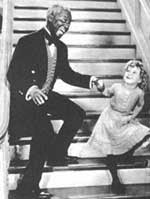You're not old enough to go to the movies yet, but you soon will be. Movies have really changed since I was a little kid, way back in the 1930s. Of course, now you can watch movies on your TV or any number of other mobile devices. I watched one just this week on my Kindle Fire.
The 1930s were known as the years of the Great Depression. For many people this was a very difficult time. We didn't notice it so much on our farm, because we could grow our own food, but it was a difficult time even for farmers like my Daddy.
Shirley Temple and Bojangles Robinson
In those years the movie industry in Hollywood suffered mildly in comparison to the rest of America. Part of its success rested in its ability to create fantasy realms of song and dance that audiences could escape into and imagine as their own reality. So long as the Hollywood studios could produce these fanciful productions with talented stars, Depression audiences paid money to escape from the problems of the world around them.
In 1935 little Shirley Temple became 20th Century Fox's leading star at the box-office. Shirley was born in 1928, five years before me. She began her film career in 1932 at the age of three, and in 1934 skyrocketed to stardom in Bright Eyes, a feature film designed specifically for her talents. She received a special Academy Award in February 1935.
In 1935 little Shirley Temple became 20th Century Fox's leading star at the box-office. Shirley was born in 1928, five years before me. She began her film career in 1932 at the age of three, and in 1934 skyrocketed to stardom in Bright Eyes, a feature film designed specifically for her talents. She received a special Academy Award in February 1935.
Shirley left the film industry at the age of twelve. You can still see her re-formatted movies today or watch them from a DVD you might rent from Netflix. You can even see her sing and dance on You Tube: On The Good Ship Lollypop.
Her films were relatively cheap to make, allowing studios to make a fine profit. She made twenty-four films—almost all inspiring song and dance comedies. Those comedies often dealt with the vitality and hope young people had even during the Depression. Examples are Curly Top, Dimples and the Little series.
In The Littlest Rebel (1935) Shirley Temple was paired with one of her favorite dance partners—Bill "Bojangles" Robinson. One of the most successful African American actors of the day, "Bojangles" became famous for his talented dance skills. Although hardly allowed to achieve the stardom that white actors could enjoy, "Bojangles" talents did not go completely unrecognized. In the movie Swing Time, Fred Astaire pays a tribute to "Bojangles" as he dances to "Bojangles of Harlem" in blackface (the first and only time Astaire performs in blackface in his film career).
Judy Garland
Another famous star of the 1930s was Judy Garland. She was 11 years older than me, but was also born in Minnesota, up in Grand Rapids. Among the most famous films of the time was the MGM production of The Wizard of Oz with Judy Garland and an amazing cast of characters. Judy Garland was not the only star that the studio had to boast of however; its star role also included Mickey Rooney and the singing pair of Nelson Eddy and Jeanette MacDonald. Judy and Mickey starred in several musicals together, such as Babes in Arms and Babes on Broadway, offering a dose of adolescent promise to Depression-escaping audiences.
____________________
In one scene from my novel, The Twins, a wealthy gangster of the Twin Cities, Teddy Banks, is busy seducing Iva Tilden, Tillie's mother. Here's part of the phone call Banks made to invite Iva to view the newest Judy Garland film.
“Iva, good morning. How are you?” said the soft voice of Teddy in her ear.
She almost dropped the phone as well. “I . . . ah . . . I’m fine.”
“And did my flowers arrive?”
“Yes, yes. They are so wonderful. What can I say?”
“You can say yes to my invitation, dear lady. I want to take you to see that wonderful new fifteen year old actress we spoke about last Saturday. Remember Judy Garland?”
“Of course. I remember. You even told me she was born in Minnesota.”
“Ah. You do remember. And do you remember where in Minnesota she was born?”
Iva began to loosen up. “Yes, silly. She was born up north, in Grand Rapids, and her birth name was Frances Ethel Gumm.”
“Bravo, my dear. Bravo. Tomorrow night we shall go to see her in that movie I told you about,
“Broadway Melody of 1938,” and we’ll hear her sing the little song she first sang to Clark Gable himself.” Teddy began to sing the lines of the song, “You made me love you. I didn’t want to do it. I didn’t want to do it.”
_____________________
Well, Byron, you won't be reading my novels for a long time, but you may enjoy watching a Shirley Temple movie even now. If you do, think about me.
Love,
GGPa


No comments:
Post a Comment
Note: Only a member of this blog may post a comment.